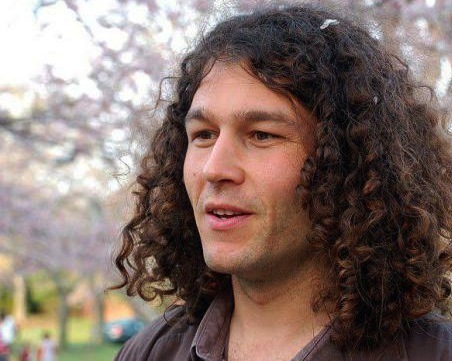Marc Abrahams's Blog, page 564
July 3, 2012
“Astounding: statistical sampling worked”
 Can one obtain a patent for a basic technique that thousands, perhaps millions of people have been using for a long, long time in many fields? Perhaps so.
Can one obtain a patent for a basic technique that thousands, perhaps millions of people have been using for a long, long time in many fields? Perhaps so.
Statistician Andrew Gelman’s blog tells of an actuary who was granted a US Patent for the concept of statistical sampling.
The actuary is Jay Vadiveloo [pictured here] of the University of Connecticut. His firsthand account of the what and how and geewhiz was published in the May 12, 2012 issue of The New York Times. He comments about applying the technique: ”To me, the results were astounding: statistical sampling worked.” Vadiveloo’s patent (U.S. #8126747) is titled “Method and system for evaluating insurance liabilities using stochastic modeling and sampling techniques“.
BONUS: You might enjoy reading about the new technique by digging up a copy of this old article:
“An investigation of the usefulness of statistical sampling methods in auditing,” J Neter, Journal of Accountancy, 1949.
(Thanks to Investigator Brenton R. Stone for bringing this to our attention,)

Mars: Fun or No Fun?
Some people — some of whom are in the Mars Society — think it would be fun to go to Mars.
Some people don’t.
The singer Camille is (at least in this song) one of the latter:

Where babies come from, start to finish: The MRI videos
You can now watch both the thrilling start and the thrilling conclusion of the process that makes babies—each in a separate, quick MRI video.
The top video shows a couple’s sexual organs while those organs were in use. The video is a spin-off from project that earned the Ig Nobel prize in medicine, in the year 2000, for Willibrord Weijmar Schultz, Pek van Andel, and Eduard Mooyaart and Ida Sabelis. The bottom video, more recent, was displayed on the New Scientist web site, under the headline “Baby’s birth captured in MRI movie for the first time“.
(Thanks to Investigator Tony Tweedale for alerting us to the consequential connection between the two videos).

July 2, 2012
Mincing vegetarians rather than words
Vegetarianism – the wanton ingestion of nothing but non-meat – sometimes produces or provokes antipathy, hostility and disgust. Researchers have struggled to understand why. In 1945, as the second world war was ending, US Army Major Hyman S Barahal, chief of the psychiatry section of Mason general hospital in Brentwood, New York, issued a report called The Cruel Vegetarian. Major Barahal began by explaining the word “vegetarianism” for anyone who might be ignorant or confused: “It consists essentially in the exclusion of flesh, fowl and fish from the dietary.”
Major Barahal drew upon his own experience at having met, and endured the presence of, several vegetarians….
So begins this week’s Improbable Research column in The Guardian.

Scientists Observe Confirmed Case of “Social Drinking”
Scientists at the University of Pittsburgh announce they’ve discovered that drinking in a social setting can increase people’s positive emotions, and help those people bond. According to the researchers, earlier studies purporting to examine this topic looked at so-called “social drinkers” when they drank alone; this study actually put social drinkers in a social setting, and found evidence supporting what many have long suspected.

Jeffrey Cohn
“Alcohol and group formation: A multimodal investigation of the effects of alcohol on emotion and social bonding,” Michael Sayette, Creswell, K. G., Dimoff, J. D., Catharine Fairbairn, Jeffrey Cohn (pictured), Heckman, B. W., et al., Psychological Science (In press). The researchers write:
“Seven-hundred-twenty social drinkers (half female) were assembled into three-person unacquainted groups, and given a moderate dose of alcohol, placebo, or nonalcohol (control) beverage, which they consumed over 36-min. [...] Alcohol consumption enhanced social experience at both individual- and group-levels (e.g., coordination of smiling, speech behaviors), and elevated self-reported bonding. Results indicate alcohol facilitates bonding during group formation.”

The overlooked Higgs particle patent
As we all (some of us) away Wednesday’s announcement from CERN about the discovery or non-discovery of the Higgs particle, let’s look at an unrelated achievement: the Higgs particle patent:
“Particulate materials”, U.S. patent #5880177, issued to Robert Philip Higgs et al. on March 9, 1999.
BONUS: Frank Wilczek talks about the Large Hadron Collider, CERN‘s complicated gizmo that has or has not discovered proof of the existence of the Higgs particle.

Your Money or Your Life: The perils of having an income
A steady paycheck has a slightly unfortunate side-effect, two researchers intimate (intimidatingly): It just might kill you. People who have money are more likely to spend money, they say—and, while doing so, engage in activities that could convert them into mortality statistics.

William Evans
“The Short-Term Mortality Consequences of Income Receipt,” William N. Evans (pictured), Timothy J. Moore, The National Bureau of Economic Research, Working Paper No. 15311, September 2009. The two economists, from the University of Notre Dame and the University of Maryland, write:
“Consumption can increase adverse health events, such as traffic accidents, heart attacks and strokes. In this paper, we examine the short-term mortality consequences of income receipt. We find that mortality increases following the arrival of monthly Social Security payments, regular wage payments for military personnel, the 2001 tax rebates, and Alaska Permanent Fund dividend payments. The increase in short-run mortality is large, potentially eliminating some of the protective benefits of additional income.”

The Golfball Index (UPDATED: May/June 2012)
 The May 2012 figures for the Golfball Index (the count of nep patents for golfballs) were again somewhat lacklustre. As in April 2012 there were just 7 new US golfball patents. But the index made good headway back into positive territory during June 2012 – when the US patent office issued no less than 10 new patents for golfballs.
The May 2012 figures for the Golfball Index (the count of nep patents for golfballs) were again somewhat lacklustre. As in April 2012 there were just 7 new US golfball patents. But the index made good headway back into positive territory during June 2012 – when the US patent office issued no less than 10 new patents for golfballs.
MAY
Casing layer for polyurethane-covered and polyurea-covered golf balls
Casing layer for polyurethane-covered and polyurea-covered golf balls
JUNE
Golf ball with single layer core having specific regions of varying hardness
Multi-layered golf balls containing polyethylene powder
Caution with regard to forward-looking statements: Historical data should not be taken as an indicator of future performance. The Golfball Index may go down as well as up.

July 1, 2012
Didgerdoo players’ glottic activity – the lowdown
An Australian didgeridoo is a reed-less hollow conically shape wooden tubular wind instrument typically measuring up to 150 cm in length, with distal and proximal diameters ranging from 150 to 30 mm. But what, exactly, happens to someone’s glottis whilst they are playing a didgerdoo?
One way of finding out is to make a video of their vocal-fold activity by using a mini-camera and associated fibre-optic cables inserted via their nose. Just such an experiment has recently been performed by a research team from the Pacific Voice and Speech Foundation, San Francisco, US.
“The data presented here comprises (as far as we were able to determine) the first ever physiologic account of vocal fold activity in a didgeridoo player observed with help of trans-nasal endoscopy.”
Based on the preliminary results of analysis of the recorded video(s), the team conclude that :
“…didgeridoo playing introduces alternations both to the phonatory component, and to the ventilatory components. Further studies utilizing aerodynamics, EGG and stroboscopic visualization are planned.”
See their paper, which was presented at the XX Annual Pacific Voice Conference, and published in the Proceedings of the Society of Photo-Optical Instrumentation Engineers (SPIE) 8207, 82072U (2012) ‘Visual observations of glottic activity during didgeridoo performance’.
A full version of the paper can be found here:
BONUS video An expert didgeridoo player in full swing.

Yakov Kronrod joins Hair Club (LFHCfS)
Yakov Kronrod has joined the Luxuriant Flowing Hair Club for Scientists (LFHCfS). Kathryn Devaney, LFHCfS, who nominated him, says:
Yakov Kronrod is a polymath whose intellectual curiosity earned him the nickname ‘professor’ long before he officially entered academia. His current areas of expertise include computational linguistics, tracking down long-lost relatives and, of course, the intricacies of maintaining luxuriant, flowing hair.
Yakov Kronrod, LFHCfS
Graduate Student in computational linguistics
University of Maryland
College Park, Maryland, USA


Marc Abrahams's Blog
- Marc Abrahams's profile
- 14 followers

























